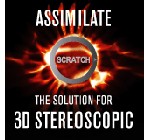Articles from: 2010
Avid Makes Big Changes with Release of Media Composer 5
 Final Cut lost one of it’s better selling features with the release of Avid’s Media Composer v5. Although Final Cut still retains it’s “one stop studio” (similar to that of the more consumer used Adobe Production Suite), Avid has now incorporated the drag and drop format for video and audio along with the ability to import footage without having to transcode. The latter being one of the biggest complaints of Final Cut users when working with Media Composer, since the ability to just grab (most) video formats and simply import them into your project in seconds has always been a primary function of workflow with FCP. Well, now Avid has finally added this convenient little feature to v5, and it will certainly take a little wind out of the sails of Final Cut’s ambitious climb to topple Avid in the post production market.
Final Cut lost one of it’s better selling features with the release of Avid’s Media Composer v5. Although Final Cut still retains it’s “one stop studio” (similar to that of the more consumer used Adobe Production Suite), Avid has now incorporated the drag and drop format for video and audio along with the ability to import footage without having to transcode. The latter being one of the biggest complaints of Final Cut users when working with Media Composer, since the ability to just grab (most) video formats and simply import them into your project in seconds has always been a primary function of workflow with FCP. Well, now Avid has finally added this convenient little feature to v5, and it will certainly take a little wind out of the sails of Final Cut’s ambitious climb to topple Avid in the post production market.
Read More
Television Loses Great Editing As 24 Comes to an End
 Well, here we go, yet another blog about one of the great television shows ending it’s series run. But I’m not here to discuss the finale or debate whether or not this show ended on a high note ( well, not really anyway ). What I really wanted to do was pay respect to the post production of one of the recent shows whose decided to pack it in after many years of entertaining us all, that show was 24. As an editor myself, one of the many draws that had me watching 24 for the last eight seasons was the way the stories were told from an editing standpoint. I’ve never seen a show that did such a unique and brilliant job of bringing in it’s story lines and make such creative use of split screens as 24 did. When the show first aired, I was completely enthralled with the originality of how it displayed real time and made use of multiple screen shots. Now after eight seasons, I can actually say that I feel that this show should go down in the annals of television as one of the most original and creative of it’s kind ( at least certainly from an editing standpoint ) . Read More
Well, here we go, yet another blog about one of the great television shows ending it’s series run. But I’m not here to discuss the finale or debate whether or not this show ended on a high note ( well, not really anyway ). What I really wanted to do was pay respect to the post production of one of the recent shows whose decided to pack it in after many years of entertaining us all, that show was 24. As an editor myself, one of the many draws that had me watching 24 for the last eight seasons was the way the stories were told from an editing standpoint. I’ve never seen a show that did such a unique and brilliant job of bringing in it’s story lines and make such creative use of split screens as 24 did. When the show first aired, I was completely enthralled with the originality of how it displayed real time and made use of multiple screen shots. Now after eight seasons, I can actually say that I feel that this show should go down in the annals of television as one of the most original and creative of it’s kind ( at least certainly from an editing standpoint ) . Read More
‘Assimilate’ Adds New Fire With Scratch v.5.1
 SCRATCH the’ Digital Finishing Solution’ by Assimilate is billed by the company as the essential mix for a real-time, resolution-dependent data workflow.Riding the RED MX Wave and beyond: The RED-ONE Digital Camera has taken the entertainment world by storm. Assimilate’s Scratch 5.1 leads the industry with first support for RED cameras, such as support for multiple RED Rocket cards in a single SCRATCH system; first dual RED Rocket support for MX R3D; and first non-RED application to support the new RED MX sensor and revised color math, with native real-time playback and adjustment of all on-camera color parameters, such as FLUT, exposure, and curves. Working easily with the native R3D files, SCRATCH streamlines the RED ONE MX workflow and delivers a high-quality master for multiple delivery formats.
SCRATCH the’ Digital Finishing Solution’ by Assimilate is billed by the company as the essential mix for a real-time, resolution-dependent data workflow.Riding the RED MX Wave and beyond: The RED-ONE Digital Camera has taken the entertainment world by storm. Assimilate’s Scratch 5.1 leads the industry with first support for RED cameras, such as support for multiple RED Rocket cards in a single SCRATCH system; first dual RED Rocket support for MX R3D; and first non-RED application to support the new RED MX sensor and revised color math, with native real-time playback and adjustment of all on-camera color parameters, such as FLUT, exposure, and curves. Working easily with the native R3D files, SCRATCH streamlines the RED ONE MX workflow and delivers a high-quality master for multiple delivery formats.
With 3D in full gear, Assimilate has given post artists the ability to work in real-time 3D at all times with direct output to any stereoscopic display system. Additionally. Assimilate offers post houses it’s exclusive 3Play Pro, which enables playback and review of full-resolution HD stereoscopic material on a variety of consumer 3D monitors, as well as non-3D monitors using a variety of Anaglyph formats. With enhanced color grading along with finishing and compositing, Scratch v.5.1 also offers support that reads and writes every DNxHD format, which provides full compatibility with AVID media for projects originating on Media Composer, Symphony, or DS.
Assimilate’s Scratch v.5.1 will be on display at this years NAB with multiple booths for those eager to test out the new features and take a test run on what is proving to be a valuable asset to those in the post community.
Cinema 4D Makes It’s Mark
 Well, I thought I would chat a bit about what has been a growing battle of the animation junket for the last few years now. When I first got into commercial work many years ago, the thought of working in full animation was basically out of the realm of possibility. There was no Cinema 4D or Maya, 3D studio max wasn’t around, and most of all, you pretty much had to work for ILM ( Industrial Light and Magic ) to use anything that possibility related to a final quality standard animation. However, as we all know, a lot has changed in the years past, so much so that now it’s a consumer’s pick as to what tool to use when working in the animation arts.
Well, I thought I would chat a bit about what has been a growing battle of the animation junket for the last few years now. When I first got into commercial work many years ago, the thought of working in full animation was basically out of the realm of possibility. There was no Cinema 4D or Maya, 3D studio max wasn’t around, and most of all, you pretty much had to work for ILM ( Industrial Light and Magic ) to use anything that possibility related to a final quality standard animation. However, as we all know, a lot has changed in the years past, so much so that now it’s a consumer’s pick as to what tool to use when working in the animation arts.
Read More
